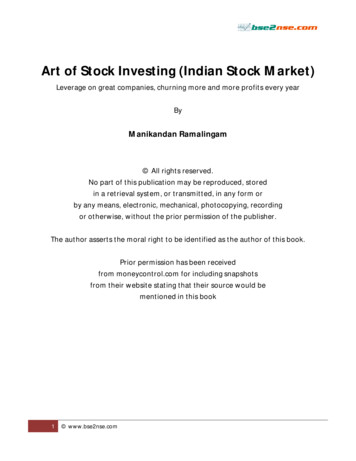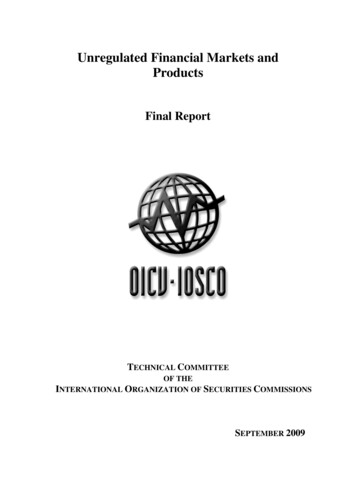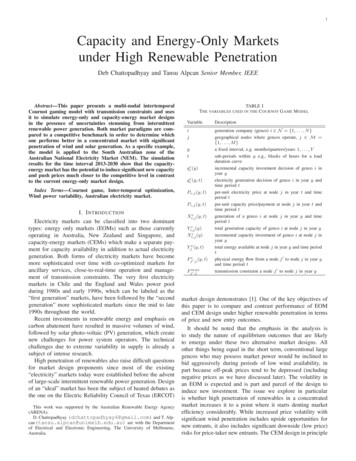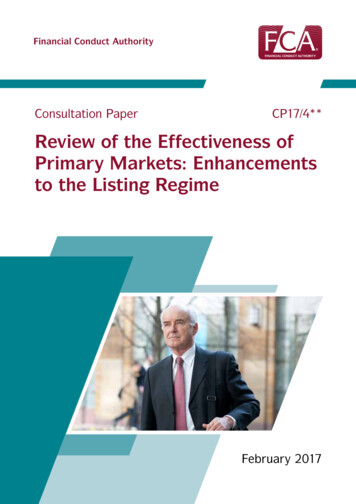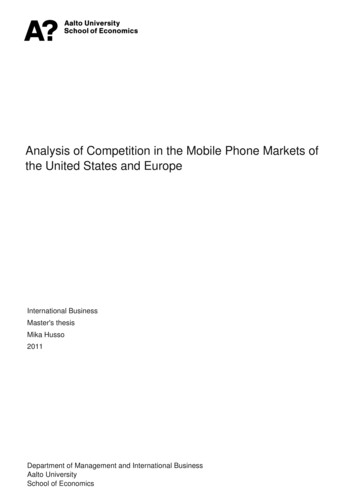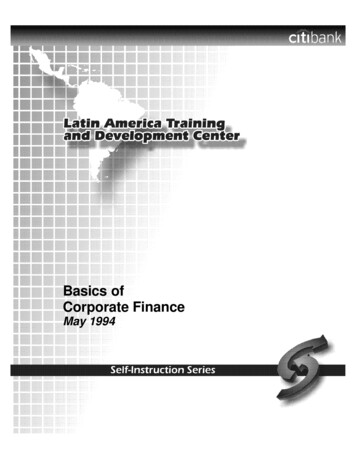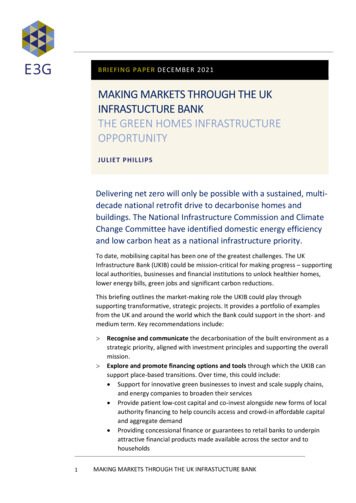
Transcription
BRIEFING PAPER DECEMBER 2021MAKING MARKETS THROUGH THE UKINFRASTUCTURE BANKTHE GREEN HOMES INFRASTRUCTUREOPPORTUNITYJULIET PHILLIPSDelivering net zero will only be possible with a sustained, multidecade national retrofit drive to decarbonise homes andbuildings. The National Infrastructure Commission and ClimateChange Committee have identified domestic energy efficiencyand low carbon heat as a national infrastructure priority.To date, mobilising capital has been one of the greatest challenges. The UKInfrastructure Bank (UKIB) could be mission-critical for making progress – supportinglocal authorities, businesses and financial institutions to unlock healthier homes,lower energy bills, green jobs and significant carbon reductions.This briefing outlines the market-making role the UKIB could play throughsupporting transformative, strategic projects. It provides a portfolio of examplesfrom the UK and around the world which the Bank could support in the short- andmedium term. Key recommendations include: 1Recognise and communicate the decarbonisation of the built environment as astrategic priority, aligned with investment principles and supporting the overallmission.Explore and promote financing options and tools through which the UKIB cansupport place-based transitions. Over time, this could include: Support for innovative green businesses to invest and scale supply chains,and energy companies to broaden their services Provide patient low-cost capital and co-invest alongside new forms of localauthority financing to help councils access and crowd-in affordable capitaland aggregate demand Providing concessional finance or guarantees to retail banks to underpinattractive financial products made available across the sector and tohouseholdsMAKING MARKETS THROUGH THE UK INFRASTUCTURE BANK
Support the private and social rented sector to decarbonise building stockSupport local authorities and others to identify project pipelines andaggregate demand to build economies of scale and reduce costs Connect transformational deals with private finance actors to deliverblended financeSupport digitalisation and smart, data-driven solutions which could helpcrowd-in further private finance, monitoring efficient use of capital and longterm benefits.Work with Government departments to consider future options to channeladditional subsidies and incentives through the Bank’s operations, as seen inGermany, helping unlock further environmental additionality and privateinvestments.Table of Contents1. The investment case: Placing importance on place-based transitions. 32. Unpacking the problem: How the UKIB can help tackle current market failures . 53. The right tools at the right time: How the UKIB can support greener homes this decade . 83.1 Examples from around the UK . 93.2 Examples from around the world . 134. The conditions for change: Policy, digitalisation and innovation . 165. Structural considerations. 196. Conclusion . 202MAKING MARKETS THROUGH THE UK INFRASTUCTURE BANK
1. The investment case: Placing importance on placebased transitionsThrough supporting green homes and places, the UK Infrastructure Bank (UKIB) canhelp close one of the largest investment gaps for net zero, making markets throughtransformative deals. A strong evidence base underscores the additionality thatsmart deployment of capital through the UKIB can offer, in a manner highlycomplementary with its four investment principles.The Bank’s first investment principle is to tackle climate change and drive regionaland local economic growth. Emissions from buildings account for 23% of the UK’stotal.1 As recognised in the Government’s recent Net Zero Strategy and Heat andBuildings Strategy, addressing this is critical for meeting climate targets. Currentlyheat and buildings represent one of the biggest climate investment gaps – with theNet Zero Strategy identifying a 120bn investment need to 2037.2 The EnergyEfficiency Infrastructure Group (EEIG) has recently highlighted a lack of support forowner occupiers classed as ‘able to pay’, who represent the largest share of the UK’shousing emissions.3 Many in this category do not have the disposable income orsavings to pay for retrofits upfront. As new regulations announced in the Heat andBuildings Strategy come into place, such as the phase out of fossil heating systems,it is vital that further assistance is made available to ensure the transition is fair,affordable and achievable.A focus on green homes can drive regional and local economic growth. A sustaineddrive to improve energy efficiency can reduce household energy bills by 7.5bn peryear to 2030,4 support 190,000 jobs across a range of trades to 2030,5 and avoidpressures on the NHS from cold, unhealthy homes – potentially saving 1.4 to 2bnannually.6 Home upgrades secure energy cost savings and increase household’sdisposable income, resulting in a persistent boost to spending and tax revenues, aswell as reducing benefit payments. This translates into spending on local goods andservices, supporting further ‘induced’ jobs,7 marking green homes out from manyother forms of investment-led growth.At the macro-level, a national retrofit drive to lower energy demand and shift toclean electric heat would reduce dependence on gas imports, redirecting system/uploads/attachment w.theeeig.co.uk/media/1114/eeig analysis-of-the-heat-and-buildings-strategy 03.pdf4https://www.theeeig.co.uk/media/1091/eeig report rebuilding for resilience pages 01.pdf5https://www.theeeig.co.uk/media/1099/eeig report turning stimulus into recovery pages web.pdf6BRE (2015) The cost of poor housing to the NHS7EC (2017) The macro-level and sectoral impacts of Energy Efficiency policies; IEA (2014) Capturing the MultipleBenefits of Energy Efficiency23MAKING MARKETS THROUGH THE UK INFRASTUCTURE BANK
onto goods and services with a stronger domestic component. Given the UK’s gasimport dependency, this is a route via which energy efficiency improvements driveGDP, which also increases economic resilience to geopolitical risks, while protectinghouseholds from volatile international gas markets. Increasing the energy efficiencyof our built environment will also deliver vital energy system-wide benefits byreducing peak demand, reducing the investment need in other areas of networkinfrastructure. This is a particularly important benefit in the context of increasinglyelectrified heating and transport systems.The Bank’s second investment principle is to support investment in infrastructureassets, networks, and new technology – prioritising clean energy, transport, digital,water and waste. Again, a focus on place-based transitions is highly complementarywith this principle. Domestic energy efficiency and low carbon heat are understoodas an infrastructure priority by the National Infrastructure Commission,8 ClimateChange Committee9 and other bodies. As the examples in Section 3 demonstrate,there are multiple infrastructure assets, networks and technologies the bank canunderpin in this area – supporting the Bank’s priority areas of clean energy anddigitalisation.The third investment principle is to deliver a positive financial return, in line with theBank’s financial framework. Multiple pilots across the UK and around the world haveproven the business case for financial models and services supporting domesticenergy efficiency and low carbon heat (see section 3), as well as other Governmentinitiatives such the Heat Networks Investment Project.10The fourth principle is that investments are expected to crowd in significant privatecapital over time. There are various examples that demonstrate that publicinvestment in retrofits spur additional private investment. For every 1 invested byGermany’s infrastructure bank KfW to incentivise renovation through interest ratesand subsidies, building owners were motivated to borrow and spend 6 – while theGovernment has nearly recouped its outlay through increased VAT revenue alone.11The UKIB can support the scaling of innovative business models along a timelinecomplementary to the regulatory pipeline set out in the recent Heat and BuildingsStrategy – supporting sustainable growth to pump-prime markets and scale supplychains. In this way, the UKIB can act as an ‘enabler of enablers’, helping support anecosystem of products and services that will become self-sustaining over time. Formore information on the sequencing to crowd in private capital, see section ploads/system/uploads/attachment data/file/1021146/Heat Networks Project Pipeline April to June 2021.pdf11Calculated from Institut Wohnen und Umwelt & Fraunhofer Institut (2018) Monitoring der KfWProgramme„Energieeffizient Sanieren“und „Energieeffizient Bauen“ 2016; BFM (2016) Haushaltsgesetz 201694MAKING MARKETS THROUGH THE UK INFRASTUCTURE BANK
2. Unpacking the problem: How the UKIB can helptackle current market failuresDespite the clear benefits associated with greener homes, a number of barriers touptake have been identified across different housing tenures. Indeed, homeinsulation rates have been steadily falling since 2010-12, following the withdrawal ofGovernment support.12 The finance sector is primed to enter this market; however,support is needed to create the right conditions. The Green Finance Institute (GFI)has profiled different market segments to understand the main barriers (table 1).13Key, cross-cutting hurdles include high upfront costs and a lack of access toaffordable finance, combined with low awareness and supply chain challenges –with limited options to aggregate demand to build economies of scale. While thereare planned policy changes which may stimulate demand, many households remainwithout support or incentive for change. The UKIB can help overcome a number ofthese barriers, including by providing access to attractive sources of capital,facilitating the de-risking of investments and supporting new consumer-focussedbusiness models. Over time, it can also provide advice to local authorities and otherstakeholders to build investable proposals and project pipelines.Table 1: Key financial and non-financial barriers to action and investment in greener wners,outrighthomeowners)UpfrontcostsLack ainOtherHigher upfront costsof lowcarbonheatingsystems vstraditionalgas boilers;costs ofwhole houseretrofitLack offinancialproductsandincentives;first-timebuyers seekto minimiseoutgoings,highlyleveraged,have limitedoptions forfurtherborrowingLong-termuncertainty onschemes,nothing onefficiency for‘able to pay’.Fragmentedmarket andaccess totrainedinstallersLack ofaccess andaccessibilityof quality,trustedadvice andinformationRegulatoryclarity forheat, but lackof clarity ment Green-Finance-Institute.pdf5MAKING MARKETS THROUGH THE UK INFRASTUCTURE BANK
PrivateRented (smalland largelandlords,assetmanagers)High upfrontcosts,particularlyfor multipropertyportfolios;currentlyunable toaggregatedemandSocial Rented(IncludingHousingAssociationsand localcouncils)High upfrontcosts todecarboniselargeportfoliosNo financialincentives orsupportLimitedcapacity toleveragecredit,limitedawarenessfor acquiringfinanceHigher costof borrowingfor HousingAssociationsthan localauthorities;many sociallandlordsclose toborrowinglimitsLack of longterm certaintyAmbiguity onnew standardsLack of longterm policycertainty andcapitalinvestmentfrom centralgovernmentFragmentedmarket andaccess totrainedinstallersLandlordtenant splitincentiveSupplychainmaturityShort-termgrant profiledifficult toreconcilewith longtermobjectivesStock oftendispersedDistrictHeating: sizeof market,lack ofregulatoryenvironmentDistrictheating: sizeof market,lack ofregulatoryenvironmentThe UKIB can help address the risk profile which might stop some lenders fromproviding finance, and limit take-up from households and other actors. A variety oftools exist which the UKIB can use to de-risk investments,14 on top of new digitaland data-driven solutions (see section 4).For example, concessional funding and guaranteed financing can help incentivisehomeowners and provide lenders confidence to enter the market. Examples of thisexist around the world, including the New York State Energy Research andDevelopment Authority’s Loan Loss Reserve programme for clean energy.15 If aborrower defaults, the loan loss reserve will reimburse the lender up to an agreedamount to mitigate their losses.Long payback periods on retrofitting projects can make traditional types of financeless attractive to homeowners. There is an opportunity for the UKIB to work withactors such as the GFI to establish a ‘demonstrator project’ of Property LinkedFinance (sometimes known as Property Assessed Clean Energy), which helps toovercome the payback challenge by linking the finance to the property rather than14156For example, see https://valueandrisk.eefig.eu/ and .ny.gov/CORE Solicitation Detail Page?SolicitationId a0rt000000x5aidAAAMAKING MARKETS THROUGH THE UK INFRASTUCTURE BANK
the property owner, enabling a longer pay-back period. Other innovative businessmodels, such as ‘heat as a service’, can also help spread the costs for homeowners.Support to scale projects which aggregate demand can also help enable the market(see section 3.1 for examples).7MAKING MARKETS THROUGH THE UK INFRASTUCTURE BANK
3. The right tools at the right time: How the UKIB cansupport greener homes this decadeTo support net zero and local economic growth, the UKIB will partner with theprivate sector financing and local authorities and develop an expert advisory serviceto help local authorities and other project sponsors develop and finance projects.While the Bank will not provide direct lending to households, capital could bechannelled through intermediaries (i.e., retail banks or local authorities) to provideconcessional finance to individuals. High-level examples of how these services couldbe utilised to decarbonise the built environment are indicated in Table 2.Table 2: Examples of how the UKIB can support place-based transitions Private sectorfinancingProvide concessionalfinance or guarantees toretail banks so they canprovide attractive offersacross all sectorsSupport clean economyactors (i.e., heat pumpmanufacturers, heatnetwork companies,retrofit firms, builders’merchants) to scalesupply and investSupport energycompanies broadentheir services (i.e.,offering ‘heat as aservice’)Support PRS andhousing associationsdecarbonise theirbuilding stockLocal Authoritylending Provide patient lowcost capital and coinvest alongside newforms of localauthority financing,such as Local ClimateBonds, to help councilsaccess affordablecapital and aggregatedemand to supportmulti-vectorinfrastructure projects(i.e., utility-scaleground-source heatpump installations,heat networks) andservices (i.e., wholestreet-retrofits, greenneighbourhoods as aservice – see examplebelow) Expert advisoryserviceSupport local authoritiesidentify project pipelinesand aggregate localdemand to buildeconomies of scale, witha joint-up approachSupport private andsocial landlordsaggregate demand andaccess affordable capitalHelp ‘match make’stakeholders (installers,engineers,manufacturers, etc) for awhole house/ streetretrofit approachConnect transformationaldeals with suitableprivate finance actors todeliver blended financesolutionsThe Bank has a range of financing tools at its disposal which could be used tosupport energy efficiency and low carbon heat measures, mapped out in Table 3.8MAKING MARKETS THROUGH THE UK INFRASTUCTURE BANK
Table 3: Examples of how the UKIB's financing tools can support place-based transitionsToolExampleSenior debt, wherethere are low levels ofliquidityProviding concessional funding to banks who then on lend thelow-cost capital to homeowners for green projects, which isthen repaid to the UKIB as customers make their repayments(similar to KfW model – see section 3.2).Hybrid products suchas mezzanineinstruments, sittingbetween senior andequity debtPotentially relevant for certain heating infrastructure projects,such as heat networks.Equity to addressconstruction risk orcrowd-in additionalinvestorsSimilar to the heat networks point above, drawing on lessonsand examples from the Heat Networks Investment Project.16Opportunities to provide initial capitalisation of a propertylinked finance scheme or heat-as-a-service business models.GuaranteesProviding credit guarantees to bankers lending to social housingproviders, reducing the cost of funds for retrofit projects.Wholesale credit guarantees on the wholesale funding thatbanks use could help reduce the interest rate of green homeproducts (e.g. green mortgages) and stimulate those markets.Loans to localSupport and co-invest alongside local authorities in projects toauthorities at the rate support place-based transitions and spur local leadership.of gilts 60bps for highvalue and strategicprojects3.1 Examples from around the UKBy strategically supporting transformative deals and business models, the UKIBcan help make new markets – addressing current market failures. A number of‘off the shelf’ examples are already being developed across the country, whichthe UKIB could help scale and mainstream. A sample of these are outlinedbelow, selected based on a high alignment with the Bank’s four investmentprinciples. The portfolio contains a mix of examples of projects which couldmake a difference today, as well as mechanisms and services which the ow-toapply9MAKING MARKETS THROUGH THE UK INFRASTUCTURE BANK
may seek to support within its longer-term strategy. We note that many of theexamples outlined below could be further supported by data and digitalsolutions outlined in section 4.Utility scale investment for ground source heat pumpsKensa Group, who manufacture and install ground source heat pump systems inthe UK, have developed a utility-style infrastructure concept to support an areabased approach to clean heat, piloted with Glasgow’s Green Street. This modelcould underpin the mass adoption of ground source heat pump technologythrough a street-by-street and split ownership approach.17 The approachresolves issues around distress purchases, network upgrades andsynchronisation of homeowner actions and could be scaled through workingwith the energy industry and suppliers to popularise a networked ground sourceheat pump solution at scale, similar to gas grid infrastructure projects.Comfort-as-a-service business modelsComfort-, or heat-, as-a-service models support the construction orrefurbishment of homes to high energy performance standards, deliveringsignificant energy bill savings that outweigh the upfront costs of retrofit. Thesemodels can be attractive to households, making retrofits easy and hassle-free.Service providers can aggregate demand (including by working with social andprivate landlords) to reduce upfront costs. Companies are already offering theseservices across the UK, including Sero.18 Supported by Energy Systems catapult,Baxi Heating UK and Bristol Energy are also supporting a heat-as-service model.19The UKIB could provide upfront finance to service providers (potentially energycompanies, retrofit companies and housebuilders) to support the initial upfrontcosts associated with retrofits, enabling the scaling of this consumer-friendlybusiness model across the country.Property Linked FinanceProperty Linked Finance enables building owners to access 100% upfront fundingfor retrofits through finance attached to the property. The responsibility forrepayments remains with the property and is passed on to subsequent ownerswho are benefitting from the installed measures. This model is based on thesuccess of Property Assessed Clean Energy (PACE) financing in the USA. PropertyLinked Finance overcomes several market barriers, including allowing longerpayback periods and therefore smaller repayments for consumers. There arevarious mechanisms for repayments that the GFI are exploring with the ervices/1810MAKING MARKETS THROUGH THE UK INFRASTUCTURE BANK
of establishing a pilot scheme in 2022. UKIB funds could be used to finance theadministrator providing the upfront cost of the scheme, or to crowd in widerinvestment or incentivise uptake by supporting concessional lending.Green-neighbourhoods-as-service (GNaaS)Bankers without Boundaries have proposed a mechanism to address thechallenge of scaling energy efficiency measures in the urban built environment.20GNaaS envisages the establishment of a central entity in a city or region whichdesigns, commissions, manages and funds deep energy retrofit on a street-bystreet scale with incremental community investments. To fund the work, amechanism attaches the long-term energy and maintenance savings to thecentralised funding source. This takes the form of a long term (30 year ) comfortand maintenance contract with the resident or property. The concept has beenmet with positive reception from multiple local authorities and financialinstitutions, who would be interested in providing upfront costs, pending ‘proofof concept’, and the mechanism being promoted through the UK Cities ClimateInvestment Commission. 21 The UKIB could help support pilot trials across theUK, which could then be scaled up, leveraging additional private finance.Energy Services Company (ESCO) in a boxESCOs provide energy solutions and financing support to organisations that wantto lower their carbon output. However, it is difficult for small and mediumbusinesses to tap into this level of expert guidance. In Oxfordshire, the ESCO-InA-Box initiative is changing this story. EP Group – an energy efficiency financeconsultancy – partnered with Low Carbon Hub and Oxford Brookes University tolaunch a scheme that would help local businesses adopt energy-savingmeasures. Many local authorities have made promises to reach net-zero in thecoming decades and initiatives like ESCO-in-a-box can help them to meetambitious targets. The scheme can be tailored to suit different regional andindustry-specific challenges across the country and around the world. 22Cardiff Capital Region data driven decarbonisationCardiff Capital Region is targeting a 51% decrease in domestic heat and poweremissions. In doing so, a digital- and fabric-first approach is being adopted,supported by the implementation of Building Retrofit Plans to accelerate longterm decarbonisation, supported by UCL’s 3D Stock Model (see section 4 formore information).23 The implementation of Building Retrofit Plans across carboncopy.eco/initiatives/esco-in-a-box23Active Building Centre Research Programme: abc-rp.com2111MAKING MARKETS THROUGH THE UK INFRASTUCTURE BANK
region will mean almost half of the population of Wales will benefit frombecoming “green finance ready”. With further funding, this model could berolled out in additional regions.Wholesale GuaranteeWholesale guarantee schemes in the UK have previously been successful athelping grow markets and crowd in private finance. A National Loan GuaranteeScheme was launched March 2012 to help businesses access cheaper finance byreducing the cost of bank loans under the scheme by 1 percentage point.24Participating banks were expected to pass on the entire benefit that theyreceived from the guarantees across the UK through cheaper loans. The packageof interventions was worth 21bn. 5bn was available initially (with a minimumallocation of 100m per bank) with the remaining available over the twofollowing years. Over 28,000 loans with a value of over 5.2bn were offered bythe participating banks.National District Heat FundLow-carbon district heating networks will be critical to achievingdecarbonisation, but district heat networks currently serve only 2% of the UK’sheat demand. This could grow to up to 20% of homes by 205025 and may requireup to 22bn of private investment to achieve.26 A National District Heat Fundwould help leverage private capital to meet this investment need. The potentialof such a model under the UKIB is exemplified by the Green Investment BankOffshore Wind Fund, which was a wholly-owned subsidiary and managed thirdparty capital. The fund targeted unlevered, operating assets, and provided aroute into the market for new investors who wished to access green UKinfrastructure assets. It attracted five UK local authority pension funds andseveral international investors, leading to the fund exceeding its targetcapitalisation of 1bn.27Urban Sensing, analytics and scalable thermal ImagingHeat loss from buildings is invisible, varies significantly from one building toanother and it has not been possible, historically, to detect, measure an-guarantee-scheme-a-cure-for-fundingproblems/#: :text age%20point.&text r-powersthrough-p1bn-target.html12MAKING MARKETS THROUGH THE UK INFRASTUCTURE BANK
catalogue heat-loss variance within building typologies and between typologiesat scale. Advances in orthothermography, photogrammetry, LiDAR and highaccuracy geo-location surveying from ground-based vehicles and unmannedaerial vehicles has been combined by the team at Swansea University28 and TheUniversity of Sheffield29 to enable heat-loss detection and measurement alongwith digital 3D reconstruction of tens of thousands of homes within a few hours.The technology being developed is end-to-end in terms of data architecturelinking robotics manufacturing to the urban sensing platforms so thatmanufactured solutions can accelerate cost reduction of fabric-first measures.These scalable techniques have the potential to provide real-world validation ofdigital tools like Building Renovation Plans, which can underpin a smart approachto green finance solutions (see section 4).Innovation partnership for deep retrofit in NottinghamNottingham City Council owns 25,000 homes. An average investment of just 20,000 per unit would generate a total investment of 540m. Nottingham istherefore well placed to develop innovative programme approaches to costeffective domestic retrofit. It has partnered with The Mayor of London’s retrofitaccelerator programme, through links with Energiesprong UK, to develop apartnership for deep retrofit. It is developing an offsite manufacturing approachto whole house low carbon retrofit with performance guarantees. Thepartnership is aimed at establishing the ‘sweet spot’ where cost effective deep,whole house retrofit can be delivered at scale. There is currently a funding gap ofc. 25,000 between the cost of offsite manufacture of external fabric measures.The investment can be justified based on long term maintenance savings,property value increases and other revenues. A lower borrowing rate forinfrastructure investment would make borrowing more affordable to support acapital spend of 30m per year.303.2 Examples from around the worldKfW – support for energy efficiency in buildings and SMEs in GermanyKfW references energy efficiency as a cornerstone of its support to tackleclimate change. Domestically, KfW offers energy efficiency programmes forproperties, SMEs and municipalities. Within 10 years, KfW has supportedmeasures in more than 4 million homes in Germany. Overall, KfW's promotional28ABC-RP.comResources, Infrastructure Systems and built Environments Discipline Department of Civil and StructuralEngineering The University of Sheffield30This case study was provided by UK100 and featured in the report An Opportunity for the UK InfrastructureBank to Accelerate the Pace of Net Zero Investment in our ublications/UKIB%20case%20studies Bristol Nottingham Leeds.pdf2913MAKING MARKETS THROUGH THE UK INFRASTUCTURE BANK
funding has triggered investments of over EUR 260 billion in building measuresand secured an average of 320,000 jobs per year in the building industry andregional trades, while helping to reduce carbon emissions by almost 9 mill
crowd-in further private finance, monitoring efficient use of capital and long-term benefits. Work with Government departments to consider future options to channel additional subsidies and incentives through the ank's operations, as seen in Germany, helping unlock further environmental additionality and private investments. Table of Contents 1.




